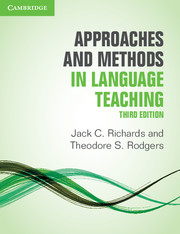Book contents
- Frontmatter
- Contents
- Acknowledgments
- Introduction to the third edition
- I Major trends in twentieth-century language teaching
- II Current approaches and methods
- III Alternative twentieth-century approaches and methods
- IV The teaching and learning environment
- Appendix: Comparison of approaches and methods
- Author index
- Subject index
4 - The Audiolingual Method
Published online by Cambridge University Press: 08 April 2022
- Frontmatter
- Contents
- Acknowledgments
- Introduction to the third edition
- I Major trends in twentieth-century language teaching
- II Current approaches and methods
- III Alternative twentieth-century approaches and methods
- IV The teaching and learning environment
- Appendix: Comparison of approaches and methods
- Author index
- Subject index
Summary
Introduction
The Coleman Report in 1929 recommended a reading-based approach to foreign language teaching for use in US schools and colleges (Chapter 1). This emphasized teaching the com-prehension of texts. Teachers taught from books containing short reading passages in the foreign language, preceded by lists of vocabulary. Rapid silent reading was the goal, but in practice teachers often resorted to discussing the content of the passage in English. Those involved in the teaching of English as a second or foreign language in the United States between the two world wars used either a modified Direct Method approach, a reading-based approach, or a reading-oral approach (Darian 1972). Unlike the approach that was being developed by British applied linguists during the same period (Chapter 3), there was little attempt to treat language content systematically. Sentence patterns and grammar were introduced at the whim of the textbook writer. There was no standardization of the vocabulary or grammar that was included. Neither was there a consensus on what gram-mar, sentence patterns, and vocabulary were most important for beginning, intermediate, or advanced learners.
However, the entry of the United States into World War II had a significant effect on language teaching there. To supply the US government with personnel who were fluent in German, French, Italian, Chinese, Japanese, Malay, and other languages, and who could work as interpreters, code-room assistants, and translators, it was necessary to set up a spe-cial language training program. The government commissioned US universities to develop foreign language programs for military personnel. Thus, the Army Specialized Training Program (ASTP) was established in 1942. Fifty-five American universities were involved in the program by the beginning of 1943.
The objective of the army programs was for students to attain conversational profi-ciency in a variety of foreign languages. Since this was not the goal of conventional foreign language courses in the United States, new approaches were necessary. Linguists, such as Leonard Bloomfield at Yale, had already developed training programs as part of their linguistic research that were designed to give linguists and anthropologists mastery of American Indian languages and other languages they were studying. Textbooks did not exist for such languages.
Information
- Type
- Chapter
- Information
- Approaches and Methods in Language Teaching , pp. 58 - 80Publisher: Cambridge University PressPrint publication year: 2014
